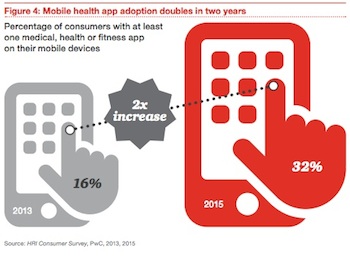Smartphone-connected device use, focus on behavioral health, and better databases for health information analysis, are within the top 10 trends in healthcare for 2016, according to PwC’s annual Health Research Institute report. HRI also released results from a survey of 1,000 US consumers.
“In 2016, millions of American consumers will have their first video consults, be prescribed their first health apps and use their smartphones as diagnostic tools for the first time,” the report reads. “These new experiences will begin to make real the dream of care anywhere, anytime, changing consumer expectations and fueling innovation.”
Health apps and connected medical devices were underutilized in 2015, according to PwC. But this will change next year, in part, because of the move away from fee-for-service care as well as advances in wireless technology. One of HRI’s main findings this year is that between 2013 and 2015, use of health-focused apps doubled. While in 2013, 16 percent of consumers said they had at least one health app on their device, in 2015, that number rose to 32 percent.
The adoption of these smartphone-connected health devices will be led by those using them for primary care and chronic disease management. These departments are already offering connected health devices, activity trackers, connected scales, health apps, and e-visits to their patients.
Cybersecurity concerns for smart health devices and apps will also be a big trend in 2016. Companies will have to take preemptive measures to maintain the trust of consumers. After a hacking incident, 51 percent of consumers said they would be hesitant to use any of the manufacturer’s devices, while a similar number of people, 50 percent, said they would be hesitant to use any connected health device.
Next year, employers will also prioritize behavioral health. According to PwC, mental health conditions cost US businesses more than $440 billion every year. These employers are focusing on issues like stigma and mental health awareness. The reach of behavioral health offerings will also increase. More primary care physicians will start using remote technology to connect with behavioral health specialists, which will ultimately help primary care teams manage routine behavioral health problems. And behavioral health doctors will use remote technology to connect directly with patients.
Patients are also on board with this trend. Some 72 percent of consumers between the ages of 18 and 44 said they would be willing to use video visits services to communicate with a mental health provider instead of going to an office visit. This number decreases to 43 percent with consumers who are 45 or older.
Another trend for 2016 will be the use of population health databases, which enable providers to identify more insights about patients. The survey found that 83 percent of patients are willing to share data with their provider if it helps providers diagnose and treat the patient and a smaller number, 73 percent, are also willing to share this data if it helps providers diagnose and treat other patients.
